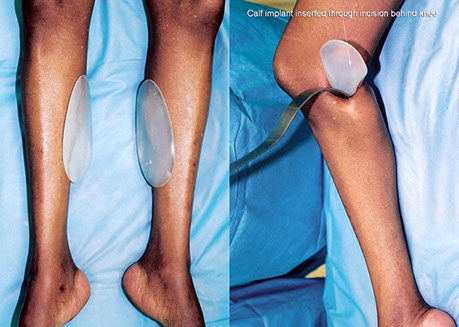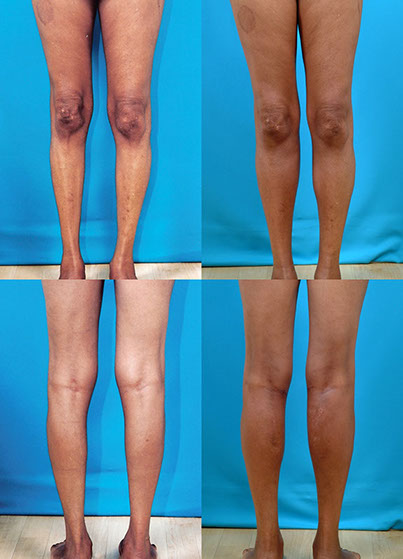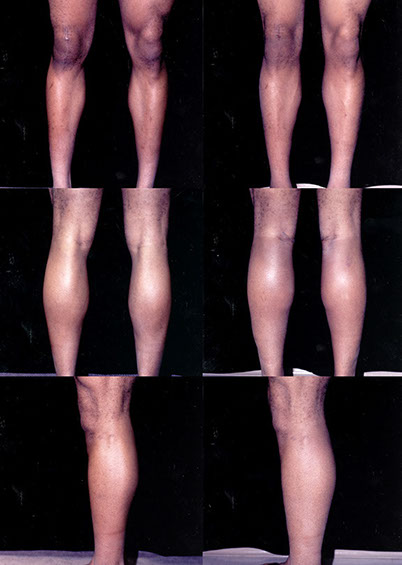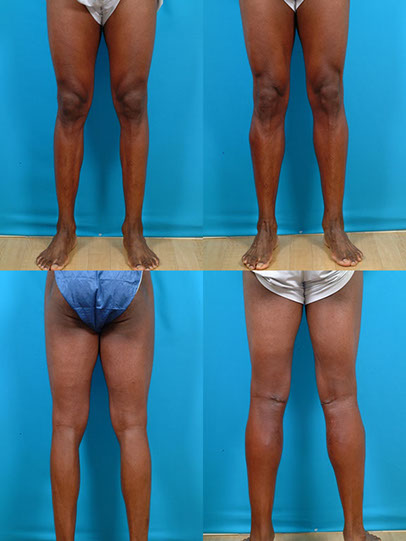
Intraoperative photo of J.N. showing the implant being inserted.
INTRODUCTION
Thin Calves
Many women and men have thin or underdeveloped calves. This condition is often inherited, but may also result from certain medical problems that affect muscle development, like polio in the past and some neuromuscular disorders. Women say that they have “chicken legs” and are reluctant to expose them. Although there is an apparent deficiency of calf muscle, no amount of exercise seems to help bulk them up. Some patients are bodybuilders who have no trouble developing their quads but cannot seem to improve their calves.
One patient of mine wore three layers of socks drawn up over his calves to help camouflage his “stick legs.” Despite working as a manager at a golf club, he would never wear shorts.
Fortunately, there is a solution—calf augmentation. This procedure helps balance proportions, so that the fullness of the calf may be in proportion to the fullness of the thigh.
PHOTOS OF PATIENTS WITH CALF AUGMENTATION
A.A., Age 25
Procedure: Calf augmentation
Before, 10 days after
J.J., Age 39
Procedure: Calf Augmentation
Description: Calf augmentation with implants and fat injection of the lateral calves.
Before, 3 weeks after
J.N., Age 58
Procedure: Calf augmentation with implants

Before, 6 weeks after
How It Is Done
A small incision is made in the crease behind the knee. A pocket is then made under the sheath that envelopes the muscle. A silicone implant is placed in this pocket. A size is chosen to provide the desired fullness without too much tension on the skin, which is the judgment call that needs to be made during surgery. While some surgeons place two implants in the calf at once, my preference is to use just one, placed in the posterior compartment where the deficiency is most obvious. If any additional augmentation is needed laterally, I prefer to use fat injection rather than a second implant. I believe this approach helps to minimize complications.
Because the implant is placed under the muscle sheath, it appears and feels natural. The implant is made of solid silicone and feels like rubber. A soft consistency (“durometer”) is chosen to help mimic the feel of the muscle.
Like a breast augmentation, the benefits are immediately apparent. Patients may go on to work out again in the gym as before, after about a month. Any increase in muscle size will compliment the result. The scar is relatively inconspicuous, located in the crease behind the knee.
What To Expect After Surgery
Your legs are wrapped with an Ace wrap from your toes to your knees. The level of discomfort is usually tolerable. You are able to get up for short trips to the bathroom. When you are sitting, keep your legs elevated on an ottoman.
I see patients the next day in the office. I remove the dressing and examine the legs. The legs are then rewrapped with Kerlix gauze and Ace wraps. Patients may start bathing when they get home. The sutures dissolve on their own. I recommend that patients wait 1 month before resuming exercises and vigorous physical activity.
Complications
Infection
Like a breast augmentation, a consequence of infection can be that the implant will need to be removed to clear the infection. It may be possible to return later to have it redone.
Hematoma
The surgical dissection is remarkably bloodless, so the risk of bleeding is low. A hematoma would cause excessive swelling and pain right after surgery and would require a trip back to the operating room.
Nerve Injury
A sensory nerve is at risk in this operation—the sural nerve, which supplies feeling to the top of the foot. If this nerve is injured, this would cause numbness over the top of the foot, including possible permanent numbness. This nerve is often used as a donor nerve in reconstructive surgery because the consequences of such numbness are minimal. Nevertheless, care is taken to preserve this nerve and avoid this possible complication.
Malposition of the implant
The implant may move after surgery and need to be repositioned.
Larger Size
There is a limit to the size that can be inserted, depending on tension of the tissues. It may be necessary to come back later, when the tissues have stretched to put in a larger implant, if desired.
Seroma
Any time a pocket is created under the skin, tissue fluid may accumulate, called a “seroma.” This fluid may need to be drained in the office.
Compartment Syndrome
If the pressure in the tissues is too great after insertion of an implant, this may cause a rare problem called “compartment syndrome.” This complication would be signaled by excessive pain, due to lack of blood supply to the muscle under the implant, and requires immediate surgical attention to release the tension.
Care After Surgery
Getting Back to Normal
- Minimal walking the first week after surgery.
- Wear Ace wraps or compression stockings to reduce swelling.
- Keep your legs elevated when not walking.
- Most people take a week off work if they do not have a very physical job.
- Full return to exercise 1 month after surgery.
FAQ’s
Q: What does the implant feel like?
A: It’s a solid silicone material, made to be as soft as possible while preserving integrity. It typically feels quite natural, not unlike muscle.
Q: When can I start working out?
A: It is best to wait 1 month before resuming exercises.
Q: How much bigger can you make my calves?
A: The skin in this area is limited in how much it can expand at one operation. The surgeon typically adjusts the implant size to maximize the result, without making the skin too tight, which might increase the risk of complications. Fine-tuning is done by shaving the implant as necessary in surgery. The result is typically noticeable and flattering.
Q: One implant or two?
A: I use one implant on each side, but there are surgeons who use two.
Q: Is the implant solid or gel-filled?
A: Like most American surgeons, I use solid silicone implants. This is a hard form of silicone, not the gel form. Implant rupture is not a concern with this type of implant.



